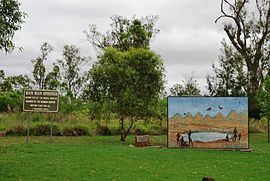Ban Ban Springs is a locality in the North Burnett Region, Queensland, Australia.[3] In the 2016 census, Ban Ban Springs had a population of 7 people.[1]
| Ban Ban Springs Queensland | |||||||||||||||
|---|---|---|---|---|---|---|---|---|---|---|---|---|---|---|---|
 | |||||||||||||||
| Coordinates | 25°40′34″S 151°49′14″E / 25.6761°S 151.8205°E | ||||||||||||||
| Population | 7 (2016 census)[1] | ||||||||||||||
| • Density | 0.343/km2 (0.89/sq mi) | ||||||||||||||
| Postcode(s) | 4625 | ||||||||||||||
| Elevation | 150 m (492 ft)[2] | ||||||||||||||
| Area | 20.4 km2 (7.9 sq mi) | ||||||||||||||
| Location |
| ||||||||||||||
| LGA(s) | North Burnett Region | ||||||||||||||
| State electorate(s) | Callide | ||||||||||||||
| Federal division(s) | Flynn | ||||||||||||||
| |||||||||||||||
Geography edit
Ban Ban Springs is located at the junction of the Burnett and Isis highways. The locality is surrounded by the larger locality of Ban Ban.[4]
On the southern side of the road junction are the springs from which the community gets its name, being rare springs from which waters flow into the nearby Barambah Creek.[5]
History edit
The name Ban Ban Springs finds its source in the name originally used by H. Herbert when, in 1846, he first leased the pastoral run encompassing the springs. It is reported Herbert borrowed the words "Ban Ban" (meaning grass) from the local Wakka Wakka and/or Kabi Kabi languages.[3]
Ban Ban State School opened in August 1916. It closed on 24 January 1965.[6]
In the 2016 census, Ban Ban Springs had a population of 7 people.[1]
Aboriginal cultural heritage edit
The natural springs were the first Queensland Aboriginal cultural heritage to be recognised on the register of the Aboriginal Cultural Heritage Act 2003.[7]
The Wakka Wakka peoples believe that the springs are significant to the Dreaming. This was confirmed by a Queensland Department of Natural Resources and Mines study advised by the Wakka Wakka Jinda.[8] The springs were entered on to the State's Aboriginal Cultural Heritage register for the following reasons:[9]
"Ban Ban [Springs] is a sacred site and has a Dreamtime association with the Rainbow Serpent which is believed to have surfaced there. It spoke to the elders of the tribe telling them the secrets of the sacred waters and how to use it. The Rainbow Serpent also told of talks he had had with the seven sisters and of the wonders he had seen while making the pathways for the sacred water to flow in this area. (This legend is retold on a mural erected at the site by elders Mavis Hawkins, Dennis and Daniel Cobbo of the Wakka Wakka tribe and their people.)"
"It is the birth place of many elders of the Wakka Wakka people with elders of this group living in the town of Gayndah."
"Ban Ban Springs is unique in Indigenous Heritage. It is sacred in men's Business and women's Business for separate and combined reasons."
"Throughout time this area has been guarded by the Rainbow Serpent."
Unfortunately, in September 2006 the Shire of Gayndah, concerned about noxious weeds (including Chinese elm) and improving visitors' experience of the area, sought to re-vegetate and beautify the place (e.g., planting out up to 30 or more bottlebrushes) by engaging contractors to promptly clear the existing vegetation from in and around the springs, with the following effect:[9]
"Cultural Heritage Destroyed: They've exposed the plant life to the summer heat, moved the rocks around, driven through the springs's pond ... They've bulldozed what Gayndah's Wakka Wakka [people] know as their cultural heritage..."
By 8 May 2007 the Queensland Department of Natural Resources and Water had issued summons under the Aboriginal Cultural Heritage Act 2003 (Qld),[9] threatening prosecution and effectively initiating discussions between the local council and the Wakka Wakka people to somehow rehabilitate the springs, better manage the Aboriginal cultural heritage area, and settle the whole matter by agreement. One year later, the council for the new North Burnett Region expressed formal regret for the harm done and agreed to discuss with the Wakka Wakka.[10]
The springs are usually dry, but local bore irrigation has also reduced the available water.[11]
See also edit
References edit
- ^ a b c Australian Bureau of Statistics (27 June 2017). "Ban Ban Springs (SSC)". 2016 Census QuickStats. Retrieved 20 October 2018.
- ^ "Ban Ban Springs Rest Area 20 Hour Limit". Caravan on Tour. Retrieved 29 March 2019.
- ^ a b "Ban Ban Springs – locality in North Burnett Region (entry 45313)". Queensland Place Names. Queensland Government. Retrieved 30 March 2019.
- ^ Google (29 March 2019). "Ban Ban" (Map). Google Maps. Google. Retrieved 29 March 2019.
- ^ Map of Ban Ban Springs Aboriginal Cultural Heritage Area Archived 5 June 2009 at the Wayback Machine, retrieved 25 February 2009
- ^ Queensland Family History Society (2010), Queensland schools past and present (Version 1.01 ed.), Queensland Family History Society, ISBN 978-1-921171-26-0
- ^ Aboriginal and Torres Strait Islander Cultural Heritage Map of Queensland (PDF), 2008, archived from the original (PDF) on 6 March 2009, retrieved 2 November 2017
- ^ "South-East Queensland Indigenous Cultural Heritage 'State of the Environment' Indicator Report". Queensland Environmental Protection Agency. 2006. Archived from the original on 8 June 2011. Retrieved 25 February 2009.
- ^ a b c Wilkinson, David (2007). "Department of Natural Resources and Water Regional Compliance Team: Protecting Queensland's Natural Resources and Cultural Heritage" Presentation to the Australasian Environmental Law Enforcement and Regulators Network Conference – 2007" (PDF). Archived from the original (PDF) on 8 October 2009. Retrieved 26 February 2009.
{{cite journal}}: Cite journal requires|journal=(help) - ^ "Minutes of General Meeting, 20 May 2008" (PDF). North Burnett Regional Council. Archived from the original (PDF) on 15 September 2009. Retrieved 26 May 2009.
- ^ "LETTERS: Why was Ban Ban Springs allowed to be pumped?". 10 November 2015. Archived from the original on 1 November 2017. Retrieved 2 November 2017.
External links edit
- Map of Ban Ban Springs Aboriginal Cultural Heritage Area, retrieved 25 February 2009
